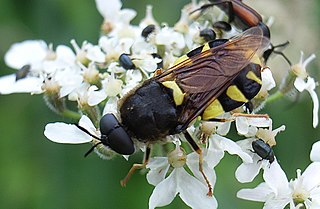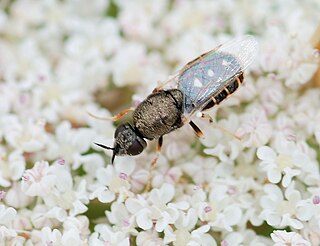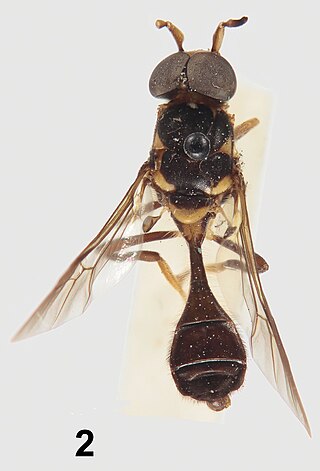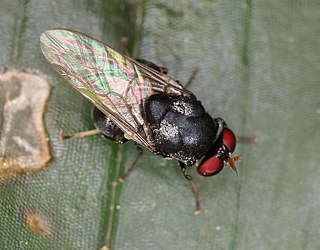
The soldier flies are a family of flies. The family contains over 2,700 species in over 380 extant genera worldwide. Larvae are found in a wide array of locations, mostly in wetlands, damp places in soil, sod, under bark, in animal excrement, and in decaying organic matter. Adults are found near larval habitats. They are diverse in size and shape, though they commonly are partly or wholly metallic green, or somewhat wasplike mimics, marked with black and yellow or green and sometimes metallic. They are often rather inactive flies which typically rest with their wings placed one above the other over the abdomen.

Stratiomyini is a tribe of flies in the family Stratiomyidae.

Camptopelta is a subgenus of flies in the family Stratiomyidae.

Nemotelus is a subgenus of flies in the family Stratiomyidae.

Nemotelus is a genus of soldier flies in the family Stratiomyidae. Nemotelus is known from the Nearctic, Afrotropical and the Palaearctic regions.

Stratiomyinae is a subfamily of flies in the family Stratiomyidae.

Beridinae is a subfamily of soldier flies in the family Stratiomyidae.

Parastratiosphecomyia stratiosphecomyioides is a species of fly in the family Stratiomyidae. It is native to Thailand. Its genus name comes from Ancient Greek, meaning "Near soldier wasp-fly", with its species name meaning "wasp fly-like". It is considered to be the animal with the longest valid scientific name; the name Gammaracanthuskytodermogammarus loricatobaicalensis, an amphipod described in 1926 by Benedykt Dybowski, was longer, but was suppressed and is no longer valid, and the bacterium Myxococcus llanfairpwllgwyngyllgogerychwyrndrobwllllantysiliogogogochensis has the longest name of any organism, but it is not an animal. P. stratiosphecomyioides, sometimes referred to as the Southeast Asian soldier fly, was described in 1923 by British entomologist Enrico Brunetti. This insect is usually between 10.3 and 10.4 mm.

Parastratiosphecomyia is a genus of flies in the family Stratiomyidae.

Prosopochrysini is a tribe of soldier flies in the family Stratiomyidae.
Paraberismyia is a genus of flies in the family Stratiomyidae.
Microhadrestia is a genus of flies in the family Stratiomyidae.
Antissella is a genus of flies in the family Stratiomyidae.

Ageiton is a monotypic genus of flies in the family Stratiomyidae. It is endemic to the Afrotropics, where it is widespread. The only species, Ageiton ater is black with short silver hairs (setae). It is similar to the three species of Cardopomyia, which are found in Madagascar.
Brachyodina is a genus of flies in the family Stratiomyidae.
Craspedometopon is a genus of flies in the family Stratiomyidae.
Diplopeltina is a genus of flies in the family Stratiomyidae. It is monotypic, being represented by the single species Diplopeltina skaifei.
Pithomyia is a genus of flies in the family Stratiomyidae.
Gongrosargus is a genus of flies in the family Stratiomyidae.
Microsargus is a genus of flies in the family Stratiomyidae.








